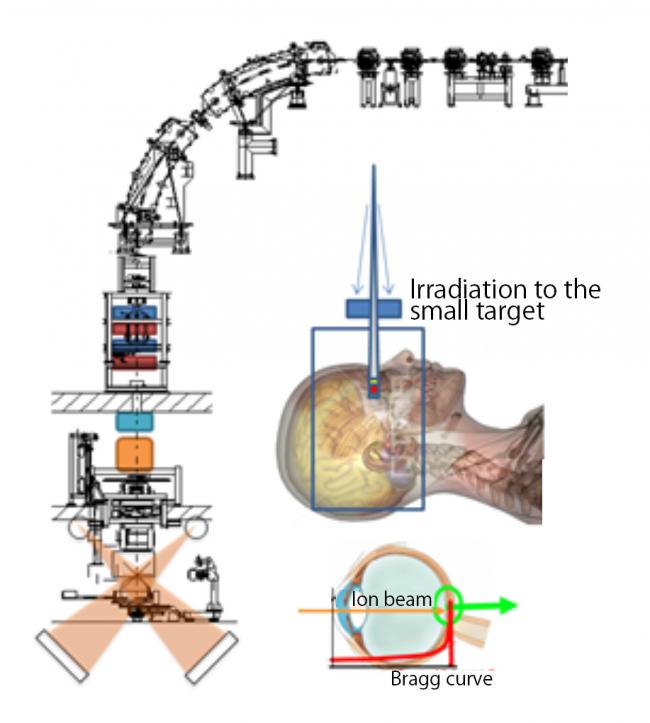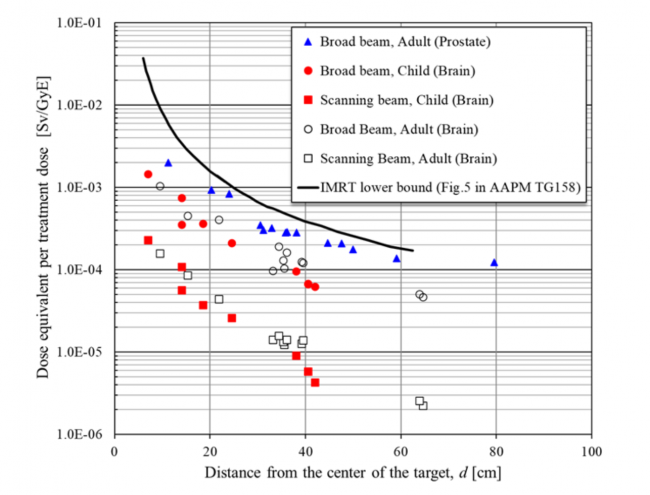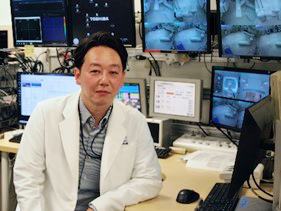When entering the treatment room, we see the beam nozzle that emits the ion beam. Upstream of the nozzle, there are various irradiation devices that produce the beam needed for treatment, as well as equipment that controls these devices. These devices, excluding the accelerator, and the control equipment are referred to as the beam delivery system. The Beam Delivery System Group is responsible for the maintenance and management of the system to ensure smooth and safe operation of the treatment and to contribute to clinical practice. In addition, our group is involved in research and development to overcome problems encountered in maintenance and management, to upgrade the beam delivery system for the future, and to improve beam quality control. Some of our efforts are briefly described below.
Toward clinical application of multi-ion therapy
In November-December 2023, QST began the world's first multi-ion-based heavy ion cancer therapy. QST has previously used only carbon beams for treatment, but multi-ion therapy also uses particles (helium, oxygen, and neon) that have not been used for treatment in the past to deliver an optimal treatment beam. To ensure the continuous implementation of this therapy, we are working in cooperation and collaboration with other groups in the Department of Accelerator and Medical Physics and QST Hospital to develop LET detectors for quality assurance and to improve the efficiency of QA and so on.
Research for the realization of microsurgery
In order to expand the application of ion beam radiotherapy, QST is engaged in various research and development efforts. The Next Generation Heavy Ion Radiotherapy Research Project aims to expand the applications of ion beam radiotherapy to benign tumors, age-related macular degeneration of the retina, vascular diseases such as cerebral aneurysms, and neurological diseases such as epilepsy. The project is conducting research and development related to methods for forming the very small irradiation field (less than a few millimeters in diameter) required for treatment and methods for quality control of these beams.

Fig. Conceptual diagram of irradiation port for microsurgery
In conventional irradiation method, the scanning electromagnets are used to make an irradiation field that matches the target (tumor). In microsurgery, however, the beam size should be focused to irradiate a very small target with electromagnets and collimators.
Research on secondary neutrons and radioactivation produced in ion beam radiotherapy
Ion beam radiotherapy uses charged particles accelerated at high speed for treatment, and there have been concerns about patient exposure and radioactivation in irradiation devices etc. due to secondary neutrons produced by the nuclear reaction between the irradiation devices or the patient and the charged particles. It is very important to consider the balance between the “risk” of exposure and the “benefit” of medical treatment in terms of patient exposure (medical exposure) received in radiation treatment.
Our group has contributed to the spread and expansion of ion beam radiotherapy by providing the fundamental data needed for such considerations through experiments and simulations, and by comparing the radiation dose and secondary cancer risk with those of other radiotherapy modalities. Although these efforts may not seem to be related to the development of irradiation system, safety assurance is an essential element in the development of medical devices, and the evaluation of waste generated during treatment and at the end of use has a major impact on the consideration of introduction ion beam radiotherapy.

Fig: Patient dose, including secondary neutrons, produced by carbon ion radiotherapy compared to the dose produced by intensity-modulated radiation therapy (IMRT) using X-rays.
Compared to the lower boundary for IMRT reported in AAPM TG158, the patient dose from carbon ion radiotherapy is clearly lower. A retrospective study conducted at QST Hospital reported that the risk of developing a second cancer after carbon ion radiotherapy is lower than that of X-ray therapy. (https://pubmed.ncbi.nlm.nih.gov/30885458/)
Member

Yonai Shunsuke Group reader
- Kumagae Tadafusa Principal Technical Staff
- Takei Hideyuki Senior Researcher
- Yonemura Miki Postdoctoral Fellow
Concurrent member
- Mizuno Hideyuki Section Manager
- Fukuda Shigekazu Deputy Director
Selected Publications
- Aoki K.,Yonai S.:New concept for neutron dosimetry in ion beam radiotherapy.Feasibility study Radiation Physics and Chemistry,223,112014,(2024)
- Matsumoto T., Aoki K., Takei H., Makino T., Yonai S., Weiss C., Griesmayer E., Ohshima T., Sakai M., Matsumura A., Kada W.:Diamond energy-dispersive dosimeter for measuring linear energy deposition distributions in clinical carbon beam therapy.Nuclear Instruments and Methods in Physics Research Section B:Beam Interactions with Materials and Atoms,554,165430,(2024)
- Ishikawa A.,Koba Y.,Furuta T.,Chang W.,Yonai S.,Matsumoto S.,Hashimoto S.,Hirai Y., Sato T.:Monte Carlo simulation study on the dose and dose-averaged linear energy transfer distributions in carbon ion radiotherapy.Radiological Physics and Technology,17,553-560 (2024)
- Iwata Y.,Shirai T.,Mizushima K.,Matsuba S.,Yang Y.,Noda E.,Urata M.,Muramatsu M.,Katagiri K.,Yonai S.,Inaniwa T.,Sato S.,Abe Y.,Fujimoto T.,Sasano T.et al.:Design of a compact superconducting accelerator for advanced heavy-ion therapy.Nuclear Instruments and Methods in Physics Research A,1053,168312 (2023)
- Furuta T.,Koba Y.,Hashimoto S.,Chang W.,Yonai S.,Matsumoto S.,Ishikawa A.,Sato T.: Development of the DICOM-based Monte Carlo dose reconstruction system for a retrospective study on the secondary cancer risk in carbon ion radiotherapy.Physics in Medicine and Biology,67(14),1-15 (2022)
- S. Lee,Mizushima K.,Yonai S.,Matsumoto S.,Mizuno H.,Nakaji T.,kohno R.,Iwata Y.,Shirai T.,Pan V.,Kok A.,Povoli M.,Tran L.,Rosenfeld A.,Suzuki M.,Inaniwa T.:Predicting the Biological Effects of Human Salivary Gland Tumour Cells for Scanned 4He-,12C-,16O-,and 20Ne-Ion Beams Using an SOI Microdosimeter.Applied Sciences,12(12),6148,(2022)
- Chang W.,Koba Y.,Furuta T.,Yonai S.,Hashimoto S.,Matsumoto S.,Sato T.:Technical Note: Validation of a material assignment method for a retrospective study of carbon-ion radiotherapy using Monte Carlo simulation.Journal of Radiation Research,62(5),846–855 (2021)
- Matsumoto S.,Yonai S.: Evaluation of neutron ambient dose equivalent in intensity-modulated composite particle therapy.Radiat Prot Dosimetry,193(2),90-95,(2021)
- Yonai S.,Matsumoto S.: Secondary Neutron Dose in Carbon-ion Radiotherapy:Investigations in QST–NIRS.Journal of Radiation Protection and Research,46(2), 39–47,(2021)
- S. H.Lee,K.Mizushima,R.Kohno,Y.Iwata,S.Yonai,T.Shirai,V.A Pan,D.Bolst,L.T.Tran,A. B.Rosenfeld,M.Suzuki and T.Inaniwa,:Estimating the biological effects of helium, carbon, oxygen, and neon ion beams using 3D silicon microdosimeters.Physics in Medicine and Biology,66(4),045017,(2021)
- S. Matsumoto, S. H. Lee, R. Imai, T. Inaniwa, N. Matsufuji, M. Fukahori, R. Kohno, S. Yonai, N. Okonogi, S. Yamada, N. Kanematsu,:Unresectable Chondrosarcomas Treated With Carbon Ion Radiotherapy:Relationship Between Dose-averaged Linear Energy Transfer and Local Recurrence.Anticancer research,40(11),6429–6435(2020)
- S.Matsumoto,S.Yonai,:Evaluation of neutron ambient dose equivalent in carbon-ion radiotherapy with energy scanning,Radiation Protection Dosimetry,191(3),310-318(2020)
- S.Yonai,S.Matsumoto,Monte Carlo study toward the development of a radiation field to simulate secondary neutrons produced in carbon-ion radiotherapy,:Radiation Physics and Chemistry,172,108787,(2020)
- S. Matsumoto,S.Yonai,W.E.Bolch,:Monte Carlo study of out-of-field exposure in carbon-ion radiotherapy:Organ doses in pediatric brain tumor treatment.Medical physics, 46(12),5824-5832,(2019)
- S.Yonai,N.Matsufuji,K.Akahane,:Monte Carlo study of out-of-field exposure in carbon-ion radiotherapy with a passive beam: organ doses in prostate cancer treatment, Physica Medica,51,48-55,(2018)
- S.Yonai,C.Arai,K.Shimoyama,N.Fournier-Bidoz,:Experimental evaluation of dosimetric characterization of gafchromic ebt3 and ebt-xd films for clinical carbon ion beams.Radiation Protection Dosimetry,170(1-4),314-318,(2018)
- S.Yonai and V.Spano,:Dose to radiological technologists from induced radionuclides in carbon ion radiotherapy.Radiation Protection Dosimetry,170(1-4),322-325,(2016)
